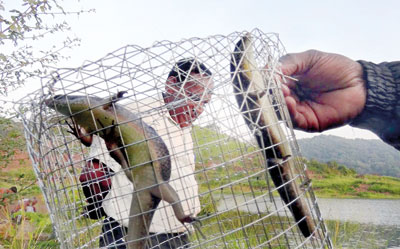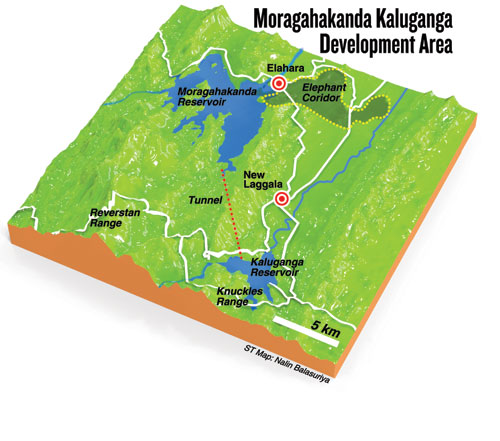News
Small creatures of Moragahakanda get a helping hand

Pix by Kanchana Kumara
Operations to rescue and relocate small wild creatures trapped by the waters of the Moragahakanda reservoir are continuing.
Filling of water at the reservoir began on January 11.
Department of Wildlife Conservation officers with support from volunteers began rescuing wildlife species that had been trapped by the rising waters.
“Giant squirrels, squirrels, wild cats, reptiles, lizards, monitor lizards and snakes top the list of animals that we rescued,” says Wildlife Department’s chief veterinary surgeon, Dr Tharaka Prasad who led the rescue.
These operations are sometimes risky. Video footage show occasions when frightened animals could endanger rescuers.
Dr Prasad said rescued animals were released into nearby forested areas that will not be affected by the waters.
He said rescuers had so far not seen any large animals such as deer, wild boar, and elephants. He believes large animals have already moved to safer ground.
The filling of the reservoir has created 22 small islands which could become refuges for animals.
Earlier, a team lead by the IUCN Sri Lanka (International Union of Conservation of Nature) carried out animal rescues in the area. IUCN Sri Lanka’s Sampath Goonatilake who participated in the operations said a number of plant species that are important and threatened were translocated. The team had also relocated some freshwater fish.
According to IUCN, 80 animal species and 202 different plant species were identified from the affected area. The operation translocated 916 plants belonging to 58 species and a total of 2,414 animals belonging to 46 faunal species (fish and other species) according to IUCN. It also states that monitoring reveals an 84 per cent survival rate of transplanted plant species.
Dr Prasad of the Wildlife Department, said officials will account for the animals saved once the rescue is complete.

| Minneriya gathering may turn sour for elephants At Moragahakanda, a dam was built at Elahara across the Amban Ganga to create a reservoir. A second dam will be built at Pallegama in Matale across Kalu Ganga to create the Kalu Ganga reservoir. These two larger water bodies are about 10 kilometres apart and will be linked by a tunnel. The project aims to provide water for drinking and irrigation for areas in Anuradhapura, Polonnaruwa and Trincomalee districts. The project also includes a hydropower plant to generate 25 megawatts of electricity. About 3,500 families had to be resettled due to the project. It is estimated that 70 per cent of the area affected by the project is forested land and it is believed that the conflicts between elephants and humans will increase. As the project aims to take water to Rajarata, tanks like Minneriya will remain filled during the dry season that lasts from July to about November. Minneriya National Park is famous for being the gathering place of large numbers of elephants every year between June and September. Environmentalists say that Minneriya being filled would be detrimental to the large herds of elephants that come feed on the lush grass growing on the plains in the dry season. |

